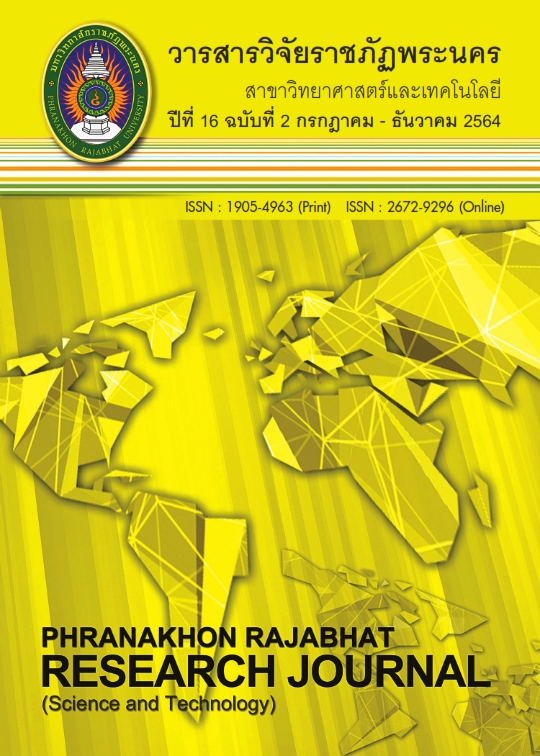การพัฒนาผลิตภัณฑ์โยเกิร์ตสดลูกจากเชื่อม
คำสำคัญ:
ลูกจาก, โยเกิร์ต, โยเกิร์ตลูกจากเชื่อมบทคัดย่อ
งานวิจัยนี้มีวัตถุประสงค์เพื่อศึกษาอัตราส่วนระหว่างน้ำกับน้ำตาลทรายในการเชื่อมลูกจาก และปริมาณการเติมลูกจากเชื่อม ร้อยละ 10 15 และ 20 ของน้ำหนัก ต่อคุณภาพโยเกิร์ต ซึ่งการเชื่อมลูกจากควรใช้อัตราส่วนของน้ำกับน้ำตาลทรายเท่ากับ 1 : 1 เมื่อนำโยเกิร์ตที่ได้มาทดสอบการยอมรับทางประสาทสัมผัสแบบ 9-point hedonic scale ในด้านลักษณะปรากฏ เนื้อสัมผัส รสชาติ กลิ่นรส และความชอบโดยรวม โดยใช้ผู้ทดสอบที่ไม่ผ่านการฝึกฝนจำนวน 100 คน พบว่าผู้บริโภคให้การยอมรับโยเกิร์ตผสมลูกจากเชื่อมสูตรที่ 1 (ปริมาณลูกจากเชื่อมร้อยละ 10) และ สูตรที่ 2 (ปริมาณลูกจากเชื่อมร้อยละ 15) ไม่แตกต่างกัน (p>0.05) โดยมีคะแนนความชอบโดยรวมที่ระดับความชอบปานกลาง อย่างไรก็ตามสูตรที่ 2 มีปริมาณเส้นใยหยาบ (0.68 %) และพลังงานทั้งหมด (111.18 Kcal/100g) สูงกว่า นอกจากนี้โยเกิร์ตผสมลูกจากเชื่อมสามารถเก็บรักษาได้นาน 5 สัปดาห์
ที่อุณหภูมิ 4 องศาเซลเซียส
เอกสารอ้างอิง
Abdel-Hamid, M., Romeih, E., Huang, Z., Enomoto, T., Huang, L. & Li, L. (2020). Bioactive properties of probiotic set-yogurt supplemented with Siraitia grosvenorii fruit extract. Food Chemistry. 103(4), 2956 – 2968.
Anawachkul, M. & Jiamyangyuenn, S. (2009). Study of GABA content and development of
GABA enriched yogurt from germinated red rice (Munpoo rice). Proceedings of 47th
Kasetsart University Annual Conference: Agro-Industry, pp 1 - 11. March 17 – 20, 2009. Bangkok. Thailand. (in Thai)
AOAC. (1990). Official Methods of Analysis. 14th ed. Vol. 2. Washington, D.C.: Association of official Analytical Chemists.
Bamroongrugsa, N. & Purintavaragul, C. (2006). Nipa palm (Nypa fruticans Wurmb.) cultivation in salt affected paddy fields. Prince of Songkla University. Hat Yai Campus, Songkhla. (in Thai)
Boonkong, S. (2011). Coursebook of food preservation and food processing about Yogurt. Dhonburi Rajabhat University. Bangkok. (in Thai)
Celik, S., I. Bakirci & Sat, I. G. (2006). Physicochemical and organoleptic properties of yogurt with cornelian cherry paste. International Journal of Food Properties. 9, 401-408.
Chaikham, P. (2015). Stability of probiotics encapsulated with Thai herbal extracts in fruit juices and yoghurt during refrigerated storage. Food Bioscience. 12(1), 61 – 66.
Daengprok, W. & Warasawas, P. (2008). Product development of longan-fortified cereal yoghurt. Maejo University. (in Thai)
Dave, R. I. & Shah, N. P. (1998). Ingredient supplementation effects on viability of probiotic bacteria in yogurt. Journal of Dairy Science. 81, 2804 – 2816.
Gad, A. S., Kholif, A. M. & Sayed, A. F. (2010). Evaluation of the nutritional value of functional yogurt resulting from combination of date palm syrup and skim milk. American Journal of Food Technology. 5(4), 250 – 259.
Hemsworth, J., Hekmat, S. & Reid, G. (2011). The development of micronutrient supplemented probiotic yogurt for people living with HIV: Laboratory testing and sensory evaluation. Innovative Food Science and Emerging Technologies. 12, 79–84.
Janyatham, J. & Sikka, P. (2012). The development of nipa palm fiber for use in product design. Art and Architecture journal naresuan university. 3 (1), 94 – 104 (in Thai)
Jariyawaranukul, U. (2009). Effect of sweetener on quality of yogurt. University of the Thai Chamber of commerce journal. 29(4), 102 – 111. (in Thai)
Katesakul, P. & Thanomchat, P. (2013). Direct use value of Nipa Palm in Ban Tha ta-pao. Knowledge management for sustainable management of coastal and mangrove forest resource: Case study of the strengthening coastal network management in community trough learning resources center in six villages, Trad province. 10 – 14. Retrieved March 15, 2019 จากhttps://www.mangrovesforthefuture.org/assets/Repository/ Documents/CbLC-Case-study22FebFinal.pdf (in Thai)
Kunpakdee, Y., Kawee, W., Woothigoon, R., Podkumnerd, N. & Sunthornaphirak, N. (2012).
Carageenan jelly with Nipa’s fruits for communities. Thaksin University Journal. 15(3) (Suppl.), 227 – 235. (in Thai)
Na Nakornpanom, N. (2011). The physico-chemical properties and survival of lactic acid bacteria of yogurt containing germinated mung bean starch. Faculty of Agricultural Product Innovation and Technology, Srinakharinwirot University. (in Thai)
Niranathmateekul, J. (Ed). (2010). Nature and Environment “Nypa fruticans” Plants that do not want to leave. Journal of medsai. 6(2), 18 – 19. (in Thai)
Petina, N.P., Granto, D., Hirota, C., Gruz, A. G., Bogsan, C. S. B. & Oloverira, M. N. (2015).
Effect of vegetal-oil emulsion and passion fruit peel-power on sensory acceptance of functional yogurt. Food Research International. 70, 134 – 141.
Phetcharat, P., Wannakhate, U. & Sarakul, S. (2010). The Comparison of chemical characteristics between cereal-milk yogurt and cow-milk yogurt. Agricultural Science ournal. 41(3/1)(Suppl.), 585-588.
Prasongchan, S., Podkumnerd, N., Pimsen, K., Sunyan, S., Sumphunthamitr, T. & Thanapha, C.(2013).
Utilization of nipa palm in the area of Songkhla lake basin Pak-Ro and Chalae Sub-districts, Singhanakhon District, Songkhla Province. Journal of community development and Life Quality. 1(1), 67 - 76. (in Thai)
Ramírez-Sucre, M. O. & Vélez-Ruiz, J. F. (2013). Physicochemical, rheological and stability characterization of a caramel flavored yogurt. LWT - Food Science and Technology. 51, 233-241.
Ranadheera, C. S., Evans, C. A., Adams, M. C. & Baines, S. K. (2012). Probiotic viability and physico-chemical and sensory properties of plain and stirred fruit yogurts made from goat’s milk. Food Chemistry. 135(3), 1411 – 1418.
Rojas-Castro, W., Chacón-Villalobos, A. & Pineda-Castro, M. L. (2007). Características del yogurt batido de fresa derivadas de diferentes proporciones de leche de vaca y cabra.
Agronomía Mesoamericana. 18(2), 221-237.
Singh, G. & Muthukumarappan, K. (2008). Influence of calcium fortification on sensory, Physical and rheological characteristics of fruit yogurt. LWT - Food Science and Technology. 41, 1145–1152.
Srisuvor, N., Chinprahast, N., Prakitchaiwattana, C. & Subhimaros, S. (2013). Effects of inulin and polydextrose on physicochemical and sensory properties of low-fat set yoghurt with probiotic-cultured banana purée. LWT - Food Science and Technology. 51(1), 30 - 36.
Supaking, J. (2019). Development of nipa palm fruit toffee product. Journal of Food Technology, Siam University. 14(1), 48 – 57. (in Thai)
Suthinoon, K. (2011). Nipa Palm management in Pak Panang Basin. Journal of Marine and Coastal Resources. 1(1), 50 – 63. (in Thai)
Unhasirikul, M., Unhasirikul, K., Thongphueak, D., Bannoen, C., Yingprayun, T. & Chantarangsi, N. (2018). Yoghurt production using local germinated brown rice cultivars from Chanthaburi Province. Agricultural Science Journal. 49 : 3 (Suppl.), 118-124.
Wang, X., Kristo, E. & LaPointe, G. (2019). Adding apple pomace as a functional ingredient in stirred-type yogurt and yogurt drinks. Food Hydrocolloids. 91, 83 – 91.
ดาวน์โหลด
เผยแพร่แล้ว
ฉบับ
ประเภทบทความ
สัญญาอนุญาต
โปรดกรอกเอกสารและลงนาม "หนังสือรับรองให้ตีพิมพ์บทความในวารสารวิจัยมหาวิทยาลัยราชภัฏพระนคร สาขาวิทยาศาสตร์และเทคโนโลยี" ก่อนการตีพิมพ์




